"Science is built up of facts, as a house is with stones. But a collection of facts is no more a science than a heap of stones is a house."
— Henri Poincaré (1854–1912)
Some daily events in the changing sky for December 5 – 13.
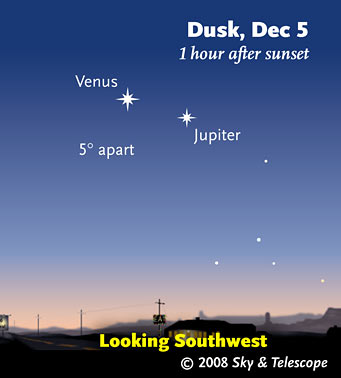
Jupiter and Venus are now drawing apart. . . .
Sky & Telescope diagram
Friday, December 5
Saturday, December 6
Sunday, December 7
Monday, December 8
Tuesday, December 9
Wednesday, December 10
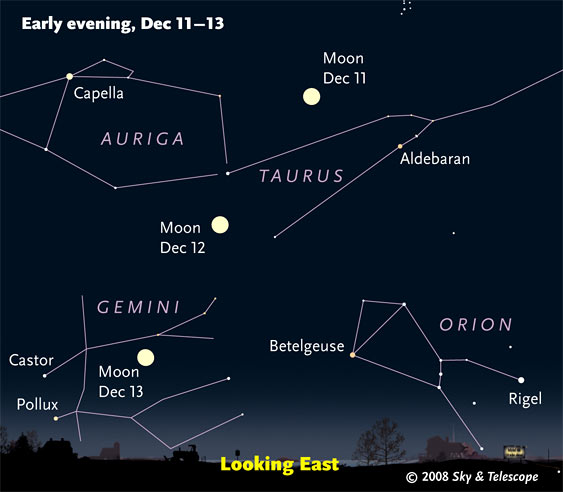
The bright Moon shines among bright constellations in the east these evenings. (These scenes are drawn for the middle of North America. European observers: move each Moon symbol a quarter of the way toward the one for the previous date. In the Far East, move it halfway.)
Sky & Telescope diagram
Thursday, December 11
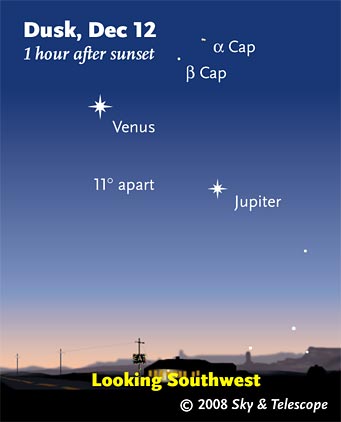
Getting farther apart. . . .
Sky & Telescope diagram
Friday, December 12
Saturday, December 13
Want to become a better amateur astronomer? Learn your way around the constellations. They're the key to locating everything fainter and deeper to hunt with binoculars or a telescope. For an easy-to-use constellation guide covering the whole evening sky, use the big monthly foldout map in each issue of Sky & Telescope, the essential magazine of astronomy. Or download our free Getting Started in Astronomy booklet (which only has bimonthly maps).

The Pocket Sky Atlas plots 30,796 stars to magnitude 7.6 — which may sound like a lot, but it's still less than one per square degree on the sky. Also plotted are many hundreds of good telescopic galaxies, star clusters, and nebulae.
Sky & Telescope
Once you get a telescope, to put it to good use you'll need a detailed, large-scale sky atlas (set of maps; the standards are Sky Atlas 2000.0 or the smaller Pocket Sky Atlas) and good deep-sky guidebooks (such as Sky Atlas 2000.0 Companion by Strong and Sinnott, the even more detailed Night Sky Observer's Guide by Kepple and Sanner, or the classic Burnham's Celestial Handbook). Read how to use them effectively.
Can a computerized telescope take their place? As Terence Dickinson and Alan Dyer say in their Backyard Astronomer's Guide, "A full appreciation of the universe cannot come without developing the skills to find things in the sky and understanding how the sky works. This knowledge comes only by spending time under the stars with star maps in hand and a curious mind." Without these, they note, "the sky never becomes a friendly place."
More beginners' tips: "How to Start Right in Astronomy".
This Week's Planet Roundup
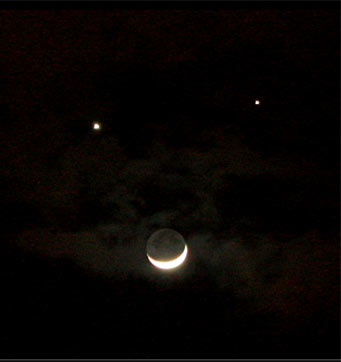
Happy conjunction is happy. On the evening of December 1, 2008, the crescent Moon made an especially good smiley face under eye-like Venus and Jupiter (squint your eyes for a better impression of it) for surprised viewers glancing up in South Asia and Australia. This shot was taken by L. N. Naveen in Bangalore, India.
Alan MacRobert
Venus and Jupiter (magnitudes –4.2 and –2.0 respectively), continue pulling apart after their Nov. 30 - Dec. 1 conjunction. They shine in the southwest during twilight. Jupiter is moving off to Venus's lower right.
In a telescope Venus is still small (17 arcseconds wide) and gibbous (67% illuminated). Jupiter is 34″ or 33″ wide but has a much lower surface brightness; being 7 times farther from the Sun, Jupiter is lit only about 1/49 as brightly.
Mercury and
Saturn (magnitude +1.1, near the hind foot of Leo) rises around midnight and shines high in the south by dawn. Don't confuse Saturn with similarly-bright Regulus 21° (about two fist-widths at arm's length) to its upper right after they rise, and directly to its right at dawn.
A telescope will show that Saturn's rings have closed to only 1° from edge on! They'll reach a minimum of 0.8° at the end of December, then start opening again, before finally closing to exactly edge-on next September — when Saturn will, unfortunately, be in conjunction with the Sun.
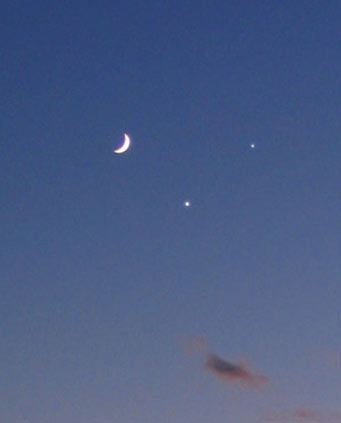
Sad conjunction is sad. Hours later, by the time of twilight in North America on December 1st, the crescent Moon had moved over to the other side of Venus and Jupiter, creating a frowny face. (Tilt your head around to see it.) Sky & Telescope's Sean Walker took this shot from New Hampshire. In the time between, the Moon crossed right over Venus for western Europe. See our photo gallery.
S&T: Sean Walker
Uranus and Neptune (magnitudes 5.8 and 7.9, respectively, in Aquarius and Capricornus) are in the southwest and south right after dark. Uranus is 0.1° from the similarly-bright star 96 Aquarii. Use our article and finder charts or the chart in the September Sky & Telescope, page 63.
Pluto is hidden in the glare of the Sun.
All descriptions that relate to your horizon or zenith — including the words up, down, right, and left — are written for the world's mid-northern latitudes. Descriptions that also depend on longitude (mainly Moon positions) are for North America. Eastern Standard Time (EST) equals Universal Time (known as UT, UTC, or GMT) minus 5 hours.
To be sure to get the current Sky at a Glance, bookmark this URL:
http://SkyandTelescope.com/observing/ataglance?1=1
If pictures fail to load, refresh the page. If they still fail to load, change the 1 at the end of this URL to any other character and try again.
 0
0
Comments
You must be logged in to post a comment.